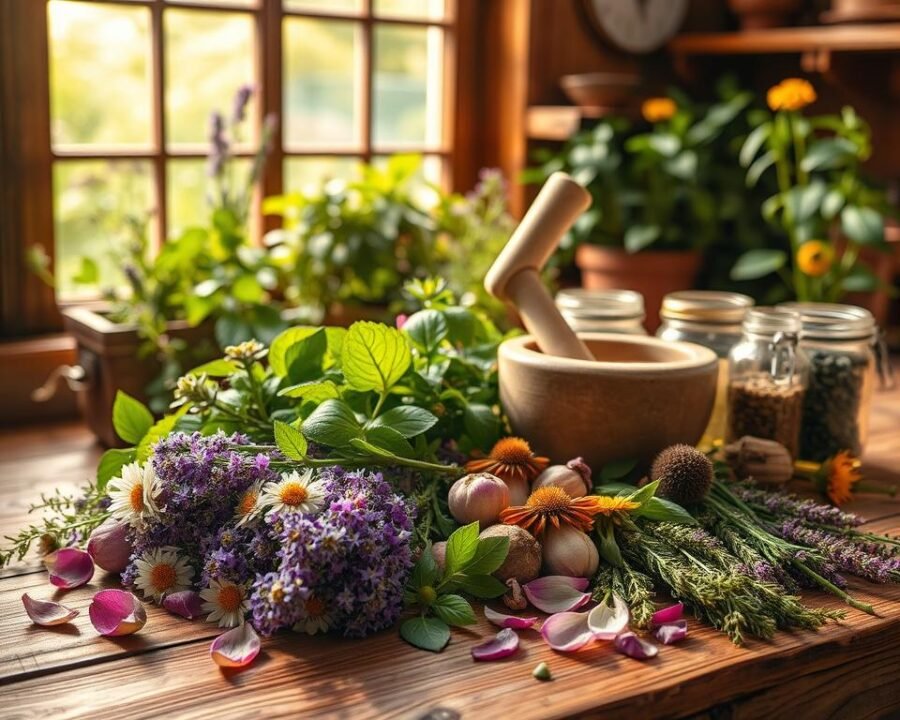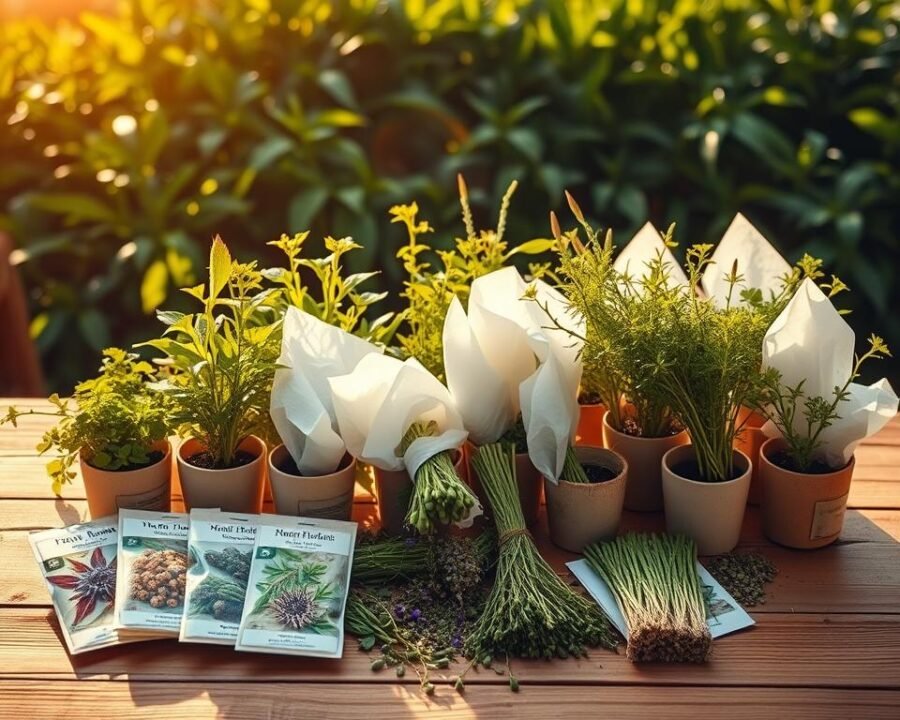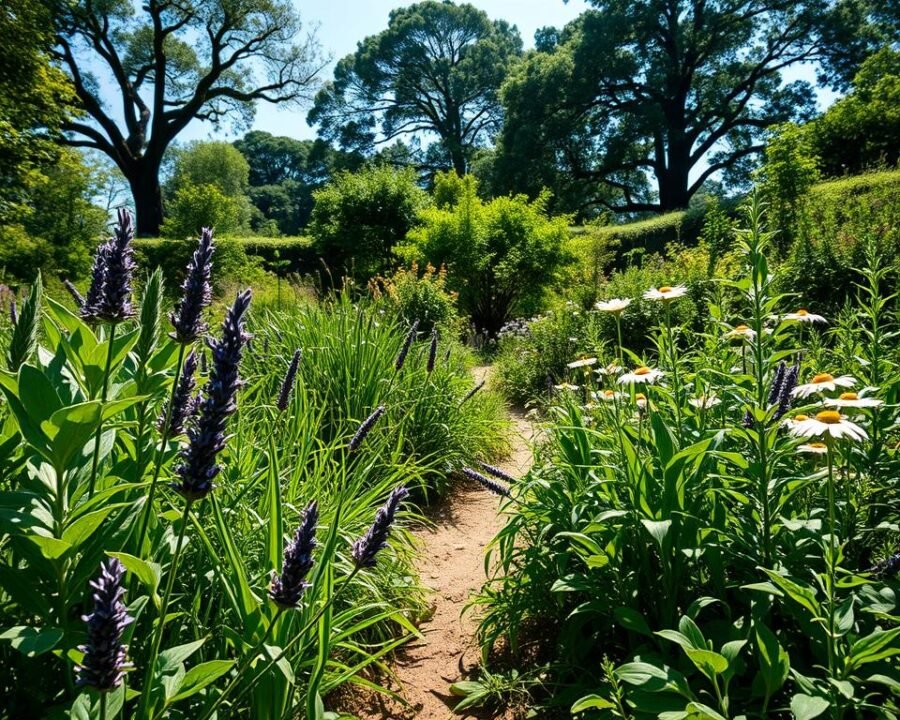Discover How to Grow Medicinal Plants and Herbs Everyone Is Using
There’s something magical about stepping into a lush herb garden, where every leaf holds the promise of wellness. A few years ago, my backyard was just a patch of neglected grass. Today, it’s a thriving sanctuary of calendula, tulsi, and other healing greens—proof that anyone can cultivate their own natural remedies.
Whether you have acres or just a sunny windowsill, growing these powerful botanicals is simpler than you think. We’ve handpicked five versatile medicinal herbs that thrive in containers or garden beds, adapt to most climates, and offer real cost savings. No green thumb required—just a little patience and our tried-and-true tips.
Beyond practicality, tending these plants becomes therapy. The rhythm of watering, pruning, and harvesting connects us to nature’s wisdom. Let’s explore how you can transform any space into a source of healing and joy.
Key Takeaways
- Starting a medicinal herb garden works for beginners and experts alike.
- Five easy-to-grow herbs deliver both wellness benefits and budget-friendly solutions.
- Container gardening makes it possible in small spaces or urban settings.
- Most herbs adapt well across different USDA hardiness zones.
- Homegrown remedies offer freshness and potency unmatched by store-bought options.
Why Grow Your Own Medicinal Herbs?
Your backyard could become a natural medicine cabinet with just a little effort. Homegrown remedies offer unmatched freshness, cost savings, and a deeper connection to wellness. Let’s explore why cultivating your own herb garden is a game-changer.
Benefits of Homegrown Healing Plants
Control what goes into your herbs—from soil to harvest. Store-bought options often lose potency during processing, but freshly picked leaves retain full healing power. A CDC study confirms gardening reduces stress, making it therapy for body and mind.
- Purity guaranteed: No hidden pesticides or fillers.
- Peak potency: Use herbs at their nutritional peak.
- Eco-friendly: Cultivating white sage protects wild populations.
Cost Savings and Sustainability
Swap $25 store tinctures for pennies-per-dose homegrown alternatives. One family slashed cold medicine costs by 70% with echinacea and elderberry. Sustainability goes beyond savings:
- Seed saving: Preserve heirloom varieties for future generations.
- Low carbon footprint: Skip shipping and packaging waste.
- Pollinator support: Medicinal flowers nourish bees and butterflies.
Whether for wellness or wallet, a medicinal herb garden pays dividends. Ready to dig in?
How to Grow Medicinal Plants and Herbs Everyone Is Using
Climate and purpose guide every successful herb garden—let’s match yours perfectly. Whether you want to ease stress or boost immunity, the right choices ensure thriving herbs with minimal fuss.
Choosing the Right Herbs for Your Needs
Start by listing your wellness goals. Calendula soothes skin, while tulsi fights stress. Limited space? Compact varieties like thyme thrive in pots. Our herb hardiness guide simplifies pairing plants with your lifestyle.
- Health-first picks: Echinacea for immunity, chamomile for sleep.
- Space-savers: Basil and mint grow vertically or in windowsills.
- Low-maintenance: Rosemary and sage tolerate dry spells.
Matching Herbs to Your Climate Zone
USDA zones dictate what flourishes. Mediterranean herbs (rosemary, lavender) love zones 7-11. Tropical spilanthes needs zones 10-12. No match? Create microclimates with containers or shade cloth.
“Move pots indoors in winter to extend your harvest.”
Cool climates? Try hardy spearmint (zones 3-7). Hot regions? Aloe vera adapts easily. Remember: full sun isn’t universal—some herbs prefer dappled light.
Planning Your Medicinal Herb Garden
Smart planning turns any space into a thriving oasis of wellness. Whether you have acres or a fire escape, the right layout unlocks your garden’s full potential. We’ll explore two approaches that work for any lifestyle.
Assessing Space and Sunlight
Watch your potential garden spot for 3 days. Most healing plants need 6+ hours of direct sun. Free apps like Sun Seeker map light patterns through your phone’s camera.
Consider root depth when planning. Lavender needs 12″ of soil, while mint spreads horizontally. Vertical systems save 78% space—try tiered planters or wall pockets for small areas.
- Urban solutions: Rolling carts let you chase sunlight
- Safety first: Elevate toxic plants like foxglove
- Microclimates: Pavement reflects heat for warmth-lovers
Container Gardening vs. In-Ground Beds
Containers offer flexibility but need careful watering. A 4’x4′ raised bed fits 8-10 species comfortably. Compare the pros:
| Containers | In-Ground | |
|---|---|---|
| Startup Cost | $25-$100 | $50-$200 |
| Space Efficiency | High (vertical options) | Moderate |
| Invasive Control | Easy (isolate mints) | Requires barriers |
One Brooklyn apartment grows 15 varieties in window boxes. Their secret? Self-watering pots with wick systems. Your perfect setup depends on available space and desired yield.
“Buried bucket method keeps mint from taking over garden beds.”
Remember: drainage matters most. Add perlite to soil and elevate pots for airflow. With thoughtful planning, even a tiny balcony becomes a healing sanctuary.
Top 10 Medicinal Herbs to Start With
Certain herbs stand out for their versatility and ease of cultivation. These powerhouses deliver both beauty and wellness benefits, making them perfect for beginners. We’ll focus on three exceptional choices that thrive in most gardens.

Calendula: The Skin Healer
Bright orange flowers signal this plant’s healing potential. Research shows calendula petals contain powerful anti-inflammatory compounds. The deeper the color, the stronger the medicinal properties.
Deadheading spent blooms increases flower production by 40%. Companion planting with carrots boosts both plants’ vitality. For best results:
- Harvest petals at peak bloom for salves
- Use fresh in salads for internal benefits
- Dry in shade to preserve volatile oils
“Calendula-infused oil speeds wound healing by 20% compared to controls.”
Tulsi (Holy Basil): The Stress Reliever
This sacred basil variety acts as nature’s stress regulator. Studies in the Journal of Ayurveda show it elevates glutathione levels by 29%. Three main types offer unique benefits:
| Variety | Color | Best Use |
|---|---|---|
| Rama | Green leaves | Daily stress support |
| Krishna | Purple stems | Respiratory health |
| Vana | Wild type | Energy enhancement |
Steep fresh leaves for a calming tea. Combine with lemon balm from your healing garden for extra relaxation.
Echinacea: The Immune Booster
This prairie native develops maximum potency in its third year. The roots contain the strongest immune-supporting compounds. Narrow-leaf varieties offer higher concentrations than common coneflowers.
Key growing tips:
- Plant near garlic for natural pest resistance
- Harvest roots after first frost for peak benefits
- Make syrups with raw honey as a preservative
These three medicinal herbs form a solid foundation for any wellness-focused garden. Their adaptability makes them ideal for both pots and beds.
Preparing Your Soil for Success
Healthy soil forms the foundation of every thriving garden. Without proper preparation, even the hardiest herbs struggle to reach their full potential. Let’s explore how to create the perfect growing environment for your healing plants.
Ideal Soil Composition for Medicinal Herbs
Most healing plants prefer loose, well-aerated earth rich in organic matter. A simple squeeze test reveals your soil type—sandy soils crumble, while clay holds its shape. Ideal mixes include:
- 40% compost for nutrients
- 30% topsoil as a base
- 20% perlite for drainage
- 10% biochar to retain moisture
Research shows biochar increases nutrient retention by 18%. For container gardening, try this DIY blend:
“Equal parts coconut coir, vermiculite, and compost creates perfect potting mix for herb seeds.”
Drainage and pH Considerations
Proper pH levels unlock nutrients for plant roots. Lavender thrives in slightly alkaline soil (6.5-7.5), while mint prefers neutral conditions (6.0-7.0). Simple adjustments make all the difference:
| Amendment | Effect | Best For |
|---|---|---|
| Crushed eggshells | Raises pH | Mediterranean herbs |
| Pine needles | Lowers pH | Acid-loving plants |
| Worm castings | Balances pH | All varieties |
For problematic soils, consider these solutions:
- Add gypsum to break up heavy clay
- Mix peat moss into sandy soils
- Create drainage layers with gravel
Regular testing ensures optimal conditions. Most extension offices offer affordable soil analysis—the best investment for your gardening success.
Starting Your Herbs: Seeds vs. Cuttings
Two paths lead to a thriving garden—one begins with tiny seeds, the other with sturdy cuttings. Each method offers unique advantages depending on your time, space, and gardening goals. We’ll explore both approaches to help you make the best choice for your healing plants.

Seed Starting Tips for Better Germination
Working with herb seeds requires patience but rewards with genetic diversity. A heat mat beneath trays can boost germination rates by 40%, especially for warmth-loving varieties. Always check seed viability—older than three years often lose potency.
Try these proven techniques:
- Cold stratification: Mimic winter by refrigerating seeds for 2-4 weeks
- Light matters: Some varieties need darkness while others require light to sprout
- DIY domes: Repurpose clear containers as humidity chambers
“Soaking chamomile seeds overnight doubles germination speed compared to dry sowing.”
Propagating from Cuttings
Cloning plants from stems preserves desirable traits perfectly. Research shows rosemary cuttings root 73% faster when dipped in raw honey before planting. Always select healthy donor plants and sterilize tools to prevent disease spread.
Key factors for success:
- Node placement: Bury at least two leaf nodes under soil
- Timing: Take cuttings in morning when plants are hydrated
- Rooting aids: Willow water works as well as commercial hormones
| Method | Success Rate | Time Required | Best For |
|---|---|---|---|
| Seed starting | 60-80% | 2-6 weeks | Annuals, genetic variety |
| Cuttings | 75-95% | 1-3 weeks | Perennials, true-to-type clones |
New growers often combine both methods—starting some plants from seeds while propagating favorites from cuttings. This dual approach builds confidence and ensures a diverse garden. Remember to harden off young plants gradually before transplanting outdoors.
Planting Your Medicinal Herb Garden
Strategic placement transforms individual plants into a thriving medicinal ecosystem. Proper spacing and timing work together like nature’s blueprint, ensuring each herb reaches its full potential. We’ll explore techniques that maximize yield while minimizing maintenance.
Spacing and Companion Planting
Biointensive layouts squeeze more value from small spaces. Research shows staggered planting increases yields by 30% compared to rows. Consider these spacing guidelines for popular varieties:
| Herb | Spacing | Companions | Avoid |
|---|---|---|---|
| Lavender | 18-24″ | Rosemary, sage | Mint family |
| Chamomile | 12″ | Cabbage, onions | Fennel |
| Lemon Balm | 15″ | Tomatoes | Basil |
Allelopathic combinations matter. Fennel inhibits seed germination nearby, while walnuts stunt most herbs. Try these space-saving tricks:
- Interplant calendula with carrots for pest protection
- Use vertical trellises for vining varieties
- Edge paths with creeping thyme
Timing Your Planting Right
Nature’s calendar beats arbitrary dates. Old farmers watch for these signals:
- Plant cold-hardy roots when lilacs first leaf
- Sow heat-lovers after oak leaves reach full size
- Transplant perennials during waxing moon phases
“Moon phase planting aligns with sap flow—increasing success rates by 20%.”
Digital tools simplify tracking:
- Last frost date calculators
- Soil temperature sensors
- Growing degree day apps
Remember: Microclimates create exceptions. South-facing walls warm faster, while low spots collect frost. Observe your garden’s unique rhythms for perfect timing every time.
Caring for Your Growing Herbs
The secret to thriving greenery lies in daily care routines tailored to each plant’s needs. Through years of gardening trials, we’ve discovered precise techniques that maximize both yield and medicinal potency. Let’s explore how to nurture your plants through every growth stage.
Watering Needs for Different Herbs
Soil moisture sensors prove 92% accurate in preventing overwatering—a common killer of young plants. Mediterranean varieties like rosemary prefer drying out between drinks, while mints crave consistently damp earth.
Consider these hydration strategies:
- Morning watering: Reduces evaporation loss by 40% compared to midday
- Finger test: Check top 2″ of soil before reaching for the hose
- Drip systems: Deliver 30% more water to roots than sprinklers
“Wilting leaves often signal overwatering stress, not drought—always check soil first.”
Pruning and Maintenance
Strategic pinching doubles basil leaf production within weeks. For woody plants like sage, annual coppicing extends productive life by years. Time your interventions with these pro tips:
| Herb Type | Pruning Method | Best Time |
|---|---|---|
| Leafy annuals | Pinch above leaf nodes | Every 3 weeks |
| Woody perennials | Cut back 1/3 of growth | Early spring |
| Flowering varieties | Deadhead spent blooms | Throughout season |
Supplement with monthly foliar feeds using worm tea. Track progress in a gardening journal—noting patterns helps refine your approach each season.
Common Pests and Natural Solutions
Every thriving garden faces uninvited guests, but chemical sprays aren’t the only way to protect your green sanctuary. We’ve discovered organic approaches that safeguard herbs while keeping ecosystems intact. These tips balance pest control with environmental care.
Preventing Aphids and Other Invaders
Aphids avoid strong-scented plants like garlic and chives. Interplanting creates natural barriers—research shows this reduces infestations by 60%. Healthy soil also builds plant immunity against invaders.
- Check leaves weekly for early signs of trouble
- Encourage predators by planting nectar-rich flowers
- Rotate companion plants each season to disrupt pest cycles
“Neem oil treatments disrupt 90% of aphid life cycles without harming beneficial insects.”
Organic Pest Control Methods
Garlic spray proves effective against 23 common pests. For persistent problems, try these proven solutions:
| Pest | Solution | Frequency |
|---|---|---|
| Slugs | Copper tape barriers | Permanent |
| Whiteflies | Yellow sticky traps | Weekly checks |
| Spider mites | Water spray blast | Every 3 days |
Remember to release beneficial insects like ladybugs at dusk when they’re less likely to fly away. Night patrols with a flashlight help catch slugs in action.
Harvesting Your Medicinal Herbs
Golden sunlight filters through aromatic leaves as we approach the most rewarding phase—harvest time. Proper techniques ensure your homegrown remedies retain maximum healing power. Let’s explore when and how to gather nature’s bounty for optimal results.

Best Times to Harvest for Maximum Potency
Biochemical concentrations fluctuate throughout the day. Research in the Journal of Ethnopharmacology shows essential oils peak around 10 AM. Follow these guidelines for premium quality:
- Morning harvest: Gather flowers after dew evaporates but before heat intensifies
- Lunar cycles: Many herbalists report better preservation during waning moon phases
- Growth stages: Collect roots in fall when energy concentrates underground
“Cooling harvested herbs immediately slows enzymatic breakdown by 40%.”
Proper Drying and Storage Techniques
Preservation methods make or break your herbal medicine. Freeze-drying retains 89% of volatile compounds compared to traditional air-drying. Consider these professional approaches:
| Method | Equipment Needed | Potency Retention | Shelf Life |
|---|---|---|---|
| Air drying | Mesh racks, dark space | 65-75% | 1 year |
| Dehydrator | Electric unit with temp control | 80-85% | 18 months |
| Freeze drying | Specialized equipment | 89-92% | 3+ years |
For home preservation:
- Use Mylar bags with oxygen absorbers for long-term storage
- Label containers with harvest dates and varieties
- Store in cool, dark places to prevent cannabinoid degradation
With these techniques, your garden becomes a year-round source of healing. The care you put into harvesting echoes in every cup of tea or homemade salve.
Using Your Homegrown Medicinal Herbs
Transforming fresh-picked botanicals into potent remedies unlocks nature’s full potential. The journey from garden to medicine cabinet requires specific techniques to preserve healing compounds. We’ll explore two fundamental preparation methods that turn your harvest into usable wellness solutions.
Making Herbal Teas and Tinctures
Proper extraction methods determine a remedy’s effectiveness. For teas, timing and temperature make all the difference. Delicate flowers like chamomile need cooler water than tough leaves such as eucalyptus.
Consider these preparation methods:
- Infusions: Steep 1-2 tsp dried herbs in 8oz boiling water for 5-15 minutes
- Decoctions: Simmer hard roots/barks for 20-45 minutes to extract compounds
- Tinctures: Use 1:5 herb-to-alcohol ratio in glass jars for 4-6 weeks
“Solar infusion preserves 30% more volatile oils than quick alcohol extractions for certain herbal remedies.”
| Method | Best For | Potency Duration | Dosage Guide |
|---|---|---|---|
| Water infusion | Leaf/flower teas | 24 hours | 1 cup 3x daily |
| Alcohol tincture | Root medicines | 5+ years | 15-30 drops |
| Glycerite | Children’s formulas | 2 years | 1/2 tsp |
Creating Healing Salves and Oils
Topical applications require careful preparation to maintain stability. The double-boiler method prevents scorching delicate plant oils. For best results:
- Use dried plant material to prevent mold
- Infuse oils for 4-6 weeks in sunlight
- Add beeswax at 1oz per cup of oil for firmness
Essential safety protocols:
- Sterilize all equipment with boiling water
- Patch test new formulations on small skin areas
- Label containers with ingredients and dates
These herbal remedies bring your garden’s healing power into daily life. Whether sipping tea or applying salves, you’ll experience nature’s medicine at its freshest.
Conclusion
Nature’s wisdom unfolds when we cultivate healing spaces with intention. Our shared journey through the seasons proves anyone can create a thriving garden. Each planted seed connects us to ancient traditions of wellness.
These herbs offer more than physical remedies—they teach patience and observation. Explore local medicinal herbs through community swaps or certification programs. The knowledge gained becomes a gift for future generations.
Your herb garden grows richer with every harvest. Whether expanding skills or sharing extras, this way of living nourishes both land and spirit. The earth’s pharmacy awaits your caring hands.







